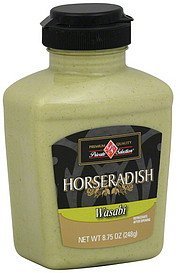Product pictures
| Amount Per 1 tsp, 5 g | |||
| Calories | 10 Kcal (42 kJ) | ||
| Calories from fat | 4.5 Kcal | ||
| % Daily Value* | |||
| Total Fat | 0.5g | 1% | |
|---|---|---|---|
| Sodium | 45mg | 2% | |
* Percent Daily Values are based on a 2000 calorie diet. Your daily values may be higher or lower depending on your calorie needs.
Find out how many calories should you eat.
Ingredients And Nutrition Overview
Best
choice Good
choice Poor
choice Avoid
it!
choice Good
choice Poor
choice Avoid
it!
-
WeightWatchers Points: 0.4, PointsPlus: 0, SmartPoints: 0
WeightWatchers Points are estimated by carbohydrates, fats, protein and fiber in product. They are not an affirmation of better quality or nutritional value of the product or its manufacturer. Only way to count for dieters. Less points are better.
Read more at Weight watchers diet review -
Convert Salt tsps to Sodium mg easily
Salt (NaCl) is not excactly sodium (Na).
It is not right to use these terms as synonyms.
The FDA recommended limit of sodium is 2,300 mg per day (or even less - about 1500 mg while one is on low sodium diets).
This is much less than the weight of salt.
(5,750 mg per day or 3,750 mg for low sodium diet) and not so convenient to calculate.
Know how much sodium is in your salt - without a calculator:
1/4 tsp salt = 600 mg sodium
1/2 tsp salt = 1200 mg sodium
3/4 tsp salt = 1800 mg sodium
1 tsp salt = 2300 mg sodium -
Product contains sulfites
Sulfites (sulphites) are inorganic salts that are used as antioxidant of food preservative or enhancer.
They may appear on food labels in various forms, such as: sulfur dioxide, potassium bisulfite, potassium metabisulfite, sodium bisulfite, sodium metabisulfite or sodium sulfite
Although sulphites do not cause a true allergic reaction, people with sensitivity to sulfites may experience similar reactions as those with food allergies.
Those who have asthma are most at risk to sulphite sensitivity.
BTW sulfites are included in the ten priority food allergens in Canada. -
Has EDTA, on FDA's toxicity watchlist
Ethylenediaminetetraacetic acid (EDTA) is a chemical added to certain foods and beverages to keep their color and flavor.
EDTA is known as a persistent organic pollutant. It resists degradation from biological, chemical, and photolytic processes.
It may irritate the skin or cause skin rash and even asthma.
It is is generally recognized as safe by FDA, but is on it's list of food additives to be studied for toxicity. -
Contains phosphoric acid
Phosphoric acid is used as an additive to acidify foods and beverages such as various colas and jams.
It provides them a tangy or sour taste and then, to mask and balance the acidity they add a huge amounts of sweeteners.
Remember! It’s a corrosive acid and can form toxic fumes when it comes into contact with alcohols, ketones and other organic compounds.
Phosphoric acid has been linked to lower bone density, dental erosion, risk of developing kidney disease.
BTW: The clear sodas that contained citric acid didn’t have the same risk.
Sources:
American Journal of Clinical Nutrition: Colas, But Not Other Carbonated Beverages, Are Associated With Low Bone Mineral Density in Older Women: The Framingham Osteoporosis Study
American Journal of Clinical Nutrition: Carbonated Beverages and Urinary Calcium Excretion
Epidemiology: Carbonated Beverages and Chronic Kidney Disease
General Dentistry: Commercial Soft Drinks: pH and in Vitro Dissolution Of Enamel
Archives of Pediatric and Adolescent Medicine: Teenaged Girls, Carbonated Beverage Consumption, and Bone Fractures
Phosphoric acid has been linked to lower bone density in some epidemiological studies, including a discussion in the American Journal of Clinical Nutrition.
Allergens
Soy Allergy, Eggs Allergy, Corn Allergy, Sulfites Allergy
Horseradish wasabi Ingredients
Horseradish (Grated Horseradish Root, Water, Soybean Oil, White Distilled Vinegar, High Fructose Corn Syrup, Eggs, Sugar, Modified Corn Starch, Salt, Lemon Juice, Xanthan Gum, Sodium Metabisulfite and Sodium Benzoate [Preservatives], Artificial Flavor, Citric Acid, Spices, Calcium Disodium EDTA [Retains Product Freshness], Paprika), Water, Mustard Seed, White Wine Vinegar, Salt, Wasabi Paste (Wasabi, Cellulose, Modified Corn Starch, Sorbitol, Salt, Xanthan Gum, Phosphoric Acid, Titanium Dioxide [for Color], Natural and Artificial Flavor, Potassium Sorbate [to Protect Flavor], Green 3 and Yellow 5), Caramel Color, Turmeric, Citric Acid, Blue 1.
You Might Also Like
% RDI of Main Nutrition Facts
1%
of RDI* (10 calories) 5 g
-
Cal: 0.5 %
-
Fat: 0.8 %
-
Carb: 0 %
-
Prot: 0 %
-
0%25%75%RDI norm*
Calories Breakdown
- Fat (100%)
Get Your Recipe of Health!
Follow RecipeOfHealth on Facebook!














Add your comment